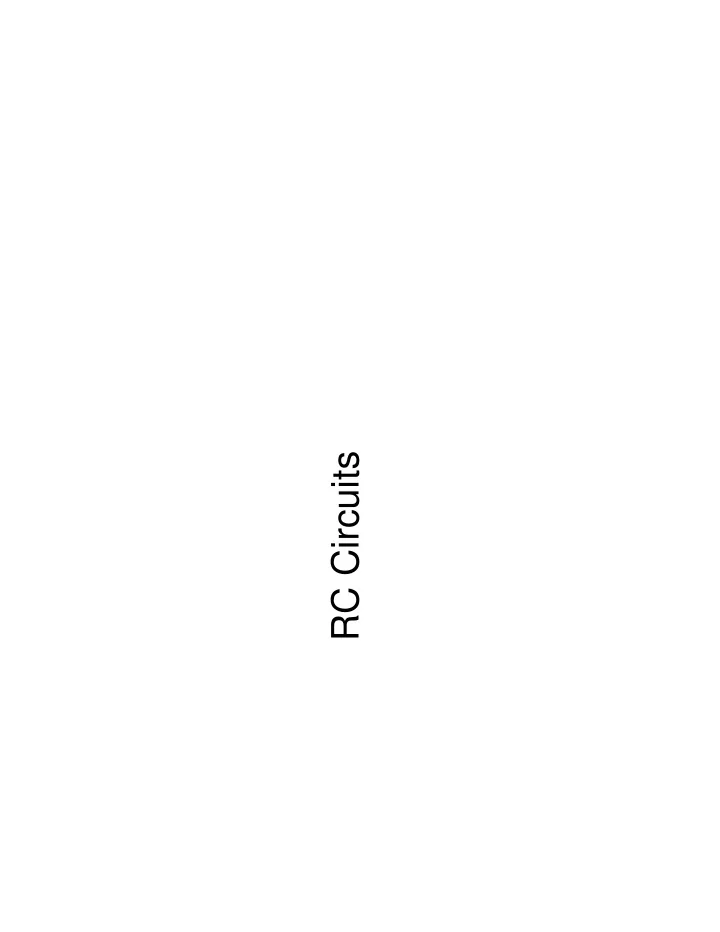

RC Circuits
RC Circuits – Charging At t=0, capacitance is uncharged and C Q=0 (initial condition). At t=0, switched is closed, it the capacitor has no charge, it behaves like a conductor and I= /R. R After the capacitor is completely charged, Q=C , V C = and V R =0. I=0 and the capacitors behave like an insulator.
RC Circuits – Charging q q d q IR R C C d t C CR dq (C - q) dt dq 1 - dt Integration constant q - C CR t n( q - C ) - K' CR R t - K' q - C Ke CR (K e ) t - q C K e CR At t 0, q 0 0 C K K - C t - q C ( 1 e CR ) t t dq C - - I e CR e CR d t CR R t - V IR e CR R V R + V C = t q - V (1 - e CR ) C C
RC time constant =RC is known as the RC time constant. It indicates the response time (how fast you can charge up the capacitor) of the RC circuit. t - I e CR R I e 2.72 R - 1 e 0 . 37 - 1 I e R ~ 0 . 37 R t t=RC t - q C ( 1 e CR ) q C 2 1.414 -1 q ( 1 e ) C 1 ~ 0 . 63 C 0 . 707 2 t Nothing to do with RC circuits t=RC
RC Circuits – Discharging At t=0, capacitance is charged with a charge Q (initial condition). At t=0, switched is closed, the capacitor starts to discharge. C R After the capacitor is completely discharged, Q=0, V C = 0, V R =0 and I=0.
RC Circuits – Discharging q q d q d q 0 IR R 0 (I - ) C C d t d t CR dq - q dt dq 1 Integration constant - dt q CR t C n q - K' R CR t - K' q Ke CR (K e ) t - q K e CR At t 0, q Q Q K t - q Qe CR t dq Q - I e CR d t RC t Q - V IR e CR R C V R + V C = 0 t q Q - V e CR C C C
In Summary For both charge and discharge, Q, I, V C , and V R must be one of the following two cases: y y 0 t - y y 0 e RC t y y t - y y (1 - e RC ) y can be Q, I, V C , or V R t
Class 26: Magnetic force acting on a moving point charge
Magnetic Field 1. All single magnets have two poles, N and S. 2. Externally, magnetic field lines come out from the N pole and getting into the S pole. 3. Between two magnets, like poles repel and unlike poles attract. 4. The geographical north pole of earth is actually the S pole of a bar magnet. 5. We will explain why there is magnetic field later.
From class 3 cross product between two vectors A B Direction: B Magnitude: A A B | A || B | sin ˆ ˆ ˆ i j k A A A A A A ˆ ˆ ˆ y z x y x z A B A A A i j k x y z B B B B B B y z x y x z B B B x y z a b ad - bc c d
From class 3 A common symbol A vector perpendicular and or pointing into the screen /paper. A vector perpendicular and or pointing out of the screen /paper.
Magnetic Force Acting on a Moving Charge When a charge particle moves in a magnetic field B, there will be magnetic force acting on the particle: B F B q v B F ` v 1. Unit of magnetic field is Tesla (T). 2. If there is magnetic field, only under two conditions the magnetic force on the charge particle will be zero: (i) the particle is not moving (v=0), or (ii) it is moving in parallel or antiparallel to the magnetic field (sin =0). 3. The magnetic force is always perpendicular to the magnetic field and the velocity. F B v 0 4. The magnetic force does no work because . 5. If you want to determine the direction acting on a negative charge particle, treat it like a positive charge first, then reverse the force direction at the end.
Recommend
More recommend